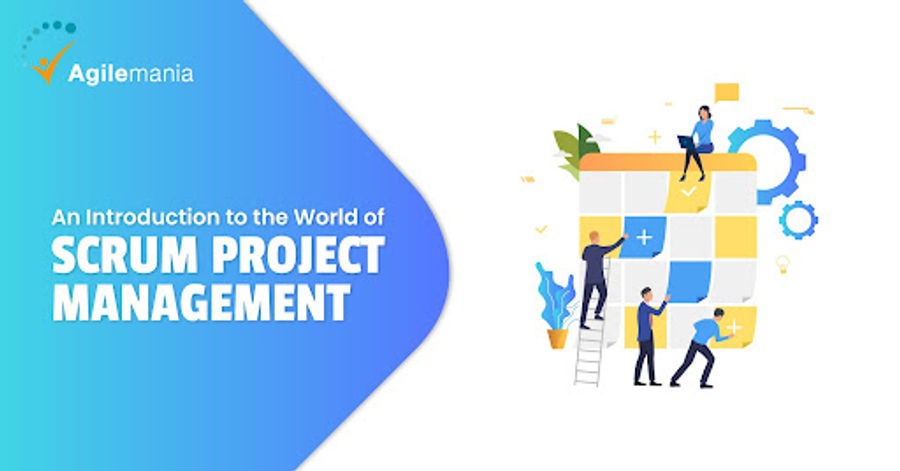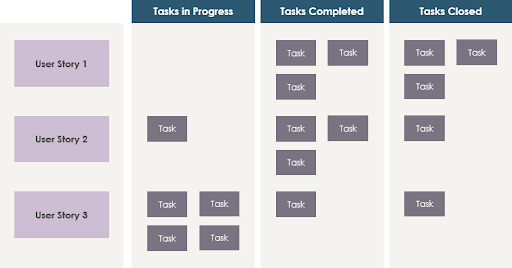
- Satyajit Gantayat
- Feb 17th 2022
Scrum is a lightweight agile framework that encourages team members to work on a problem together. It helps teams to gather knowledge from experience and learn self-organization through working on an issue. Scrum is based on Empiricism, which means knowledge comes from experience. Scrum encourages teams to improve by reflecting on their success and losses.
Scrum follows three basic principles- clear progress, regular inspection, and adaptation. Software development teams use scrum to deliver working software to the customers. However, the lessons and principles of scrum are relevant to all types of teamwork. A lot of people often get confused between scrum and agile. They think both are the same, but they are different. Although scrum follows the values & principles of agile, it's a framework for solving complex problems. On the other hand, agile is more of a mindset and change in culture. You can't convince your team to put effort and dedication into developing an agile mindset.
But you can help them achieve an agile mindset by implementing agile values & principles through the scrum framework. For those who are still not aware of the concept of the scrum, we have everything you need in this article. We will introduce you to scrum and its artifacts, events, and most importantly, its benefits. So, read on to know about scrum.
Who uses Scrum?
Do you know that scrum won't judge you by your industry? Although the scrum framework was created keeping the software developers in mind, it has nothing to do with your business. Anyone can use this framework to solve complex problems. And that is one of the reasons why scrum is so popular and widely accepted. The ideal scrum team is made with a small group of highly adaptive people who are not afraid to receive feedback, adapt to change, and deliver iteratively. So, here are three crucial components of a scrum team.The Scrum Master
The scrum master is a servant leader or a project manager who ensures that the execution of the scrum framework is successful. They are responsible for coaching the team to self-organize. The scrum framework has some clear goals and principles. The scrum master makes sure the team is following the principles effectively. Here are some of the responsibilities of a scrum master-- Helps the team members in becoming self-managed by coaching them
- Helping the Scrum Team focus on creating high-value Increments that are releasable to the end users
- Ensuring that all Scrum events take place and are positive, productive, and kept within the timebox
- The scrum master conducts 1:1 meetings with an individual team member. These 1:1 team interactions are vital for resolving team disagreements and know the areas for improvement.
- The scrum master helps to analyze the burndown charts to understand the work progress.
- The scrum master can facilitate change or help remove roadblocks that are harming the team’s progress
- Facilitating stakeholder collaboration as needed
- Helps other stakeholders in the organization understand the scrum framework
- Plans and advises Scrum implementations within the organization;
- Helps employees and stakeholders understand and enact an empirical approach for complex work
- Facilitates effective communication between stakeholders and scrum teams.
Want to become a Scrum Master? Enroll in the Professional Scrum Master (PSM-I) Certification Training
The Product Owner
The product owner is the voice of the customers. They ensure the customers’ voice is getting heard effectively. A product owner is accountable for maximizing the value by effectively managing the product and product backlog. They determine the priority of the items. The product owner must stay available to the development team to ensure the team gets the clarification they need to be in the right direction.
That means they have to return to emails, calls and attend meetings, demos frequently. The product owner will ensure the product backlog is transparent and visible to every stakeholder. They coach the team about the items in the product backlog. If the team needs any answers regarding any requirements in the product backlog to achieve their scrum goal, the product owner comes to help.
The product owner stays with the team from the beginning to the end of the software development project. They must have excellent communication skills and empathy to understand different individuals in the team.
Become a Product with the Professional Scrum Product Owner (PSPO-I) Certification Training.
Developers
Developers are a group of programmers, developers, writers, designers, and everyone who helps to build a usable product with the highest possible quality. Developers primarily have the following characteristics:
- Developers know how to be self-organized. No one tells them how to turn product backlog into a potentially releasable product increment during the sprint.
- There is no other title for the developers in scrum. The skills might be different, but everyone is a developer
- They are cross-functional. They have all the necessary skills required for delivering a working product.
- They work with a commitment to accomplish the sprint goal every sprint and deliver high-quality products.
A-Z of the Scrum Artifacts
Scrum artifacts are like some vital tools that are needed to achieve a sprint goal. Scrum Artifacts ensure transparency of information. Here is what you need to know about scrum artifacts.Product Backlog
A product backlog is a prioritized list that includes all the items your development team needs to deliver a product or make changes. The product owner is responsible for managing the backlog. You can make continuous improvements in the product backlog based on the changes and improvements in the developing product.
It is a live document which is refined continuously. The product backlog lists every feature, user story, use cases, bug fixes, and all the improvements that enable any changes to be made in the future release of the product. The developers help the product owner in estimating the items in the backlog.
Sprint Backlog
Sprint backlog includes a list of items that your development team picks from the product backlog to accomplish during the upcoming sprint. The sprint backlog states to the team how much work is needed to achieve the sprint goal. You can maintain the sprint backlog as a spreadsheet. Also, you can use scrum or agile software to manage the sprint backlog. Owned by the developers, this also includes a plan that the developers will follow to achieve the sprint goal.
User Story
User stories help us to understand a software feature from an end-user view. They help clarify the product user and describe what a user expects from the product and its reason. An example of a typical user story is: As a(role), I want (feature) because (reason).Everything You Need to Know About Scrum Ceremonies
Scrum project management is all about following some organized, time-boxed events, also known as scrum ceremonies. The main purpose of such ceremonies is to help scrum teams develop products effectively without wasting much time.Sprint Planning: Sprint planning or sprint meeting occurs at the start of each sprint. The planning ensures that the development team is all set to work on the product development. In scrum planning, the scrum master, product owner, and the development team meet together to discuss and review the prioritized items in the product backlog. During this planning, the teamwork on creating a sprint backlog. The Sprint Goal is also created during the Sprint Planning event and then added to the Sprint Backlog. In the sprint planning, the entire team answers some important questions like:
- What will be delivered in the next sprint?
- How will the team achieve the sprint goal?
Sprint Review: After each sprint, the entire scrum team (scrum master, product owner, development team) organizes a sprint review meeting. Key stakeholders are invited to provide their feedback in the work done by the scrum team. The scrum presents the result of their work done during the sprint. It's an informal meeting in nature, where everyone shares their opinion, feedback on what they need to do in the next sprint. At the end of the sprint review, the team creates a revised product backlog that lists the item for the next sprint.
Sprint Retrospective: Before the next sprint planning and after the sprint review, the sprint retrospective happens. In the Retrospective, the team discusses what they did right, what went wrong in the previous sprint. And how they could do better in the next sprint. It helps them to understand the room for improvement in the next sprint. The scrum master, product owner, and the development team attends sprint retrospective.
A sprint retrospective typically lasts 1-2 hours for a 2-week-long sprint. So, now that we’ve covered everything you need to know about scrum, let’s move on to know how scrum works: Let’s say HealthyWealthy is a newly launched application. It takes care of all our health care needs. The HealthyWealthy company assigned Chris as the software product owner to develop some app features. The development team for the product was made of a group of designers, developers, testers, writers, and analysts.
The team works collaboratively to deliver the product effectively. The company also assigned Martha as the Scrum Master to lead the team, run the meetings, and keep everything in a process. As a product owner, Chris’s first job is to document the requirements. He invites customers, and other stakeholders, to discuss the requirements. After collecting the product requirements, Chris writes them down in the product backlog. Next, along with the development team, Chris starts to prioritize items from the product backlog. The high-priority items are put in the sprint backlog as user stories. At the end of each sprint, these user stories will become the deliverable software.
Sprint Planning
During the sprint planning, Chris presents the prioritized product backlog items to the team. Together the team discusses if they have enough equipment, capacity, and everything else to convert these requirements to working software. After a long discussion, Chris and the scrum team agreed to complete the product development in 2 sprints.They will work on the user stories 1,3,4,5,6 in the first sprint. And items 2 and 7 will be completed in the next sprint. After planning Martha, the scrum master calls the development team to show how they will implement the items. The tasks are written down on the scrum board, and every team member chooses a task to work on.
Sprint 1- (Day 1) On the first day, the entire scrum team meets for their daily scrum meeting. The team discusses- what they achieved till now, what they are planning to work on today, if there’s any scope of problems, etc. After 10-15 minutes of scrum meeting, everyone gets back to their work. The scrum master, Martha, helps the team update the scrum board and the sprint burndown chart.
Sprint 1- (Day 5) In the morning, the whole scrum team gets together for the daily scrum meeting. If they face any problem with the user stories while working on their product development project, they connect with Chris to ask for advice.
Sprint 1- (Day 30)
Sprint Review
The final day of the first sprint starts with a sprint review meeting. Martha and Chris were both present in the review meeting. The team presented a developed application with a new software implementation. Chris checks the app to ensure the features are meeting his expectations. At the end of the sprint review meeting-
- The team has completed 1, 4,5,6 stories successfully.
- However, they were unable to finish story 3 as expected. So, it requires more attention and re-factoring.








